
What is paediatric Cataract Surgery?
Paediatric or child cataract surgery involves removing the clouded natural lens and replacing it with an artificial lens (IOL) or using glasses or contact lenses for focusing, focusing to restore vision and prevent permanent vision loss.
If any rules for paediatric Cataracts?Yes, here are 7 rules. The sum of postoperative refractive goal and age of the child is 7, and target refraction is decided accordingly: +6 for a 1-year-old, +5 for a 2-year-old, +4 for a 3-year-old, +3 for a 4-year-old, +2 for a 5-year-old, +1 for a 6-year-old, plano for a 7.
Symptoms and Diagnosis
What are Congenital Cataracts?
Congenital cataract is a clouding of the eye's natural lens that is present at birth or develops shortly after, potentially causing vision problems. Cataract surgery in children with congenital cataract is complicated and challenging, and proper management is necessary to prevent permanent vision loss.
How can I resolve Paediatric Cataracts?
Treatment depends on the type, whether in one or both eyes, and severity of the cataracts. But most children need surgery to remove them. Unlike adults with full-sized eyes, children require special surgical equipment and techniques. When performed by an experienced eye surgeon, cataract removal is generally safe. Eye patching, or occlusion therapy, involves working the stronger eye to encourage the weaker eye to develop better vision, and it's particularly relevant in pediatric cataracts, where it can help prevent or treat amblyopia .
Dr Tanmay Biswas has more than 10 years experience in this field. He has new modern technology for treating paediatric cataract amongst children. He has soft behaviour and his skill is extraordinary on this field.
Cataracts can be removed through a safe, quick surgical process. After removal, most adults and children receive a permanent artificial lens, called an intraocular lens (IOL). This is an option for infants, too. IOLs can additionally affect babies and their parents and the discomfort of daily contact lens changes.
Book Your Consultation for Paediatric Cataract Treatment with Dr. Tanmoy Biswas
If your child has been diagnosed with a paediatric cataract or you're concerned about their vision, contact us to schedule a consultation with Dr. Tanmoy Biswas. Early treatment is essential for preserving your child’s eyesight and overall development. Book an appointment today and take the first step towards better vision for your child.
Frequently Asked Questions
Signs of paediatric cataract include blurry or cloudy vision, an eye that appears cloudy or white, abnormal eye movements, difficulty seeing in bright light, or strabismus (crossed eyes). If you notice any of these symptoms in your child, it’s important to consult an eye specialist as soon as possible.
Yes, paediatric cataract surgery is generally safe when performed by an experienced ophthalmologist. It is a routine procedure, and the majority of children recover well with the right post-operative care. Early intervention is crucial for the best outcome.
Recovery time can vary, but most children start to heal within a few weeks after the surgery. It’s important to attend all follow-up appointments to monitor healing and ensure proper vision development.
In some cases, yes. After cataract surgery, some children may need corrective glasses or contact lenses to address any refractive errors such as nearsightedness or farsightedness. Your ophthalmologist will provide guidance on the best options for your child.
If you notice any signs of a cataract, such as cloudy vision, unusual eye appearance, or strabismus, it's important to seek medical attention immediately. An eye exam will be needed to diagnose the condition and determine the appropriate course of treatment.

